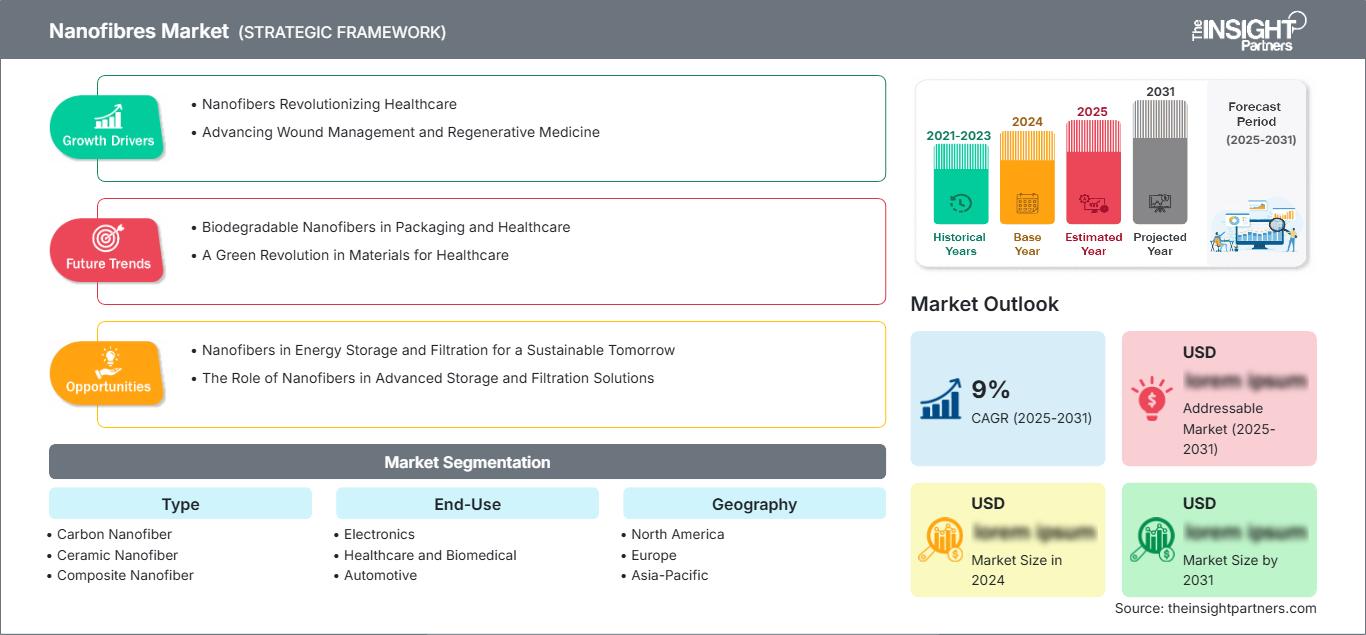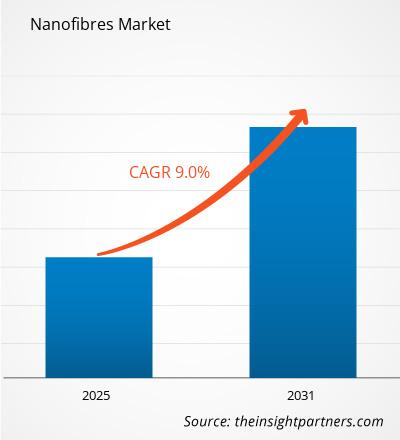Si prevede che il mercato delle nanofibre registrerà un CAGR del 9% dal 2025 al 2031, con una dimensione del mercato in espansione da XX milioni di dollari nel 2024 a XX milioni di dollari entro il 2031.
Il rapporto è segmentato per tipologia (nanofibra di carbonio, nanofibra ceramica, nanofibra composita, nanofibra di vetro, nanofibra metallica, nanofibra polimerica e altre). Il rapporto presenta un'analisi basata sull'uso finale (elettronica, sanità e biomedicina, automotive, prodotti chimici e materiali, aerospaziale e aviazione, difesa e sicurezza, tessile, altri). L'analisi globale è ulteriormente suddivisa a livello regionale e per i principali paesi. Il rapporto offre il valore in dollari per l'analisi e i segmenti sopra indicati.
Scopo del rapporto
Il rapporto sul mercato delle nanofibre di The Insight Partners mira a descrivere il panorama attuale e la crescita futura, i principali fattori trainanti, le sfide e le opportunità. Ciò fornirà spunti a vari stakeholder aziendali, come:
- Fornitori/produttori di tecnologia: per comprendere le dinamiche di mercato in evoluzione e conoscere le potenziali opportunità di crescita, consentendo loro di prendere decisioni strategiche informate.
- Investitori: per condurre un'analisi completa delle tendenze in merito al tasso di crescita del mercato, alle proiezioni finanziarie del mercato e alle opportunità esistenti lungo la catena del valore.
- Organismi di regolamentazione: per regolamentare le politiche e le attività di controllo nel mercato con l'obiettivo di ridurre al minimo gli abusi, preservare la fiducia degli investitori e sostenere l'integrità e la stabilità del mercato.
Tipo di segmentazione del mercato delle nanofibre
- Nanofibra di carbonio
- Nanofibra ceramica
- Nanofibra composita
- Nanofibra di vetro
- Nanofibra metallica
- Nanofibra polimerica
Uso finale
- Elettronica
- Sanità e biomedicina
- Automobilistico
- Prodotti chimici e materiali
- Aerospaziale e aviazione
- Difesa e sicurezza
- Tessile
Potrai personalizzare gratuitamente qualsiasi rapporto, comprese parti di questo rapporto, o analisi a livello di paese, pacchetto dati Excel, oltre a usufruire di grandi offerte e sconti per start-up e università
Mercato delle nanofibre: Approfondimenti strategici

- Ottieni le principali tendenze chiave del mercato di questo rapporto.Questo campione GRATUITO includerà l'analisi dei dati, che vanno dalle tendenze di mercato alle stime e alle previsioni.
Fattori di crescita del mercato delle nanofibre
- Le nanofibre rivoluzionano l'assistenza sanitaria: l'assistenza sanitaria e le applicazioni mediche sono uno dei principali motori di crescita del mercato delle nanofibre. Le loro proprietà insolite, come l'elevata area superficiale e la porosità, le classificano come eccellenti candidate per numerose applicazioni mediche. Sono ampiamente utilizzate per medicazioni per ferite, ingegneria tissutale e sistemi di somministrazione di farmaci, con conseguente miglioramento dell'efficacia del trattamento e dei risultati per i pazienti.
- Progresso nella gestione delle ferite e nella medicina rigenerativa: le nanofibre offrono traspirabilità e protezione, favorendo al contempo la ritenzione idrica nella cura delle ferite. Questo è un ambiente di guarigione perfetto che riduce i tassi di infezione e accelera ulteriormente la guarigione. Ciò è dovuto al fatto che soluzioni efficaci e innovative sono un aspetto su cui molti operatori sanitari stanno concentrando la loro attenzione; pertanto, la domanda di prodotti a base di nanofibre nella gestione delle ferite è destinata ad aumentare. Le nanofibre sono state adottate nell'ingegneria tissutale come impalcature per la crescita e la differenziazione cellulare. La loro somiglianza strutturale con le matrici extracellulari naturali, oltre alla loro biocompatibilità, le rendono candidate ideali per la rigenerazione dei tessuti. Con l'aumento dell'attenzione all'uso della medicina rigenerativa, si prevede che questa tendenza possa ulteriormente intensificare la domanda di nanofibre.
Tendenze future del mercato delle nanofibre
- Nanofibre biodegradabili nel packaging e nel settore sanitario: le nanofibre biodegradabili saranno probabilmente una delle tendenze future più importanti nel mercato delle nanofibre. Le crescenti preoccupazioni ambientali generano una forte domanda di materiali sostenibili da parte di tutti i settori. Le nanofibre biodegradabili possono essere considerate opzioni ecologiche disponibili per le fibre sintetiche tradizionali e, pertanto, risultano molto attraenti in termini di sostenibilità per produttori e consumatori. Ciò renderà le nanofibre fondamentali nelle applicazioni di packaging; di conseguenza, una delle principali riduzioni dell'impatto ambientale. Le nanofibre sono degradabili; pertanto, comportano meno rifiuti e inquinamento nelle discariche. Una regolamentazione più stringente sulla plastica monouso aumenterà la domanda di prodotti biodegradabili, sostituendo le nanofibre nelle soluzioni di imballaggio sostenibili.
- Una rivoluzione verde nei materiali per l'assistenza sanitaria: le nanofibre biodegradabili stanno attualmente emergendo come concorrenti nel settore sanitario per lo sviluppo di medicazioni per ferite e sistemi di somministrazione di farmaci. Poiché si decompongono in modo sicuro nell'organismo, aiutano nelle loro applicazioni temporanee per ridurre al minimo le complicazioni e accelerare la guarigione. In linea con l'attenzione del settore sanitario verso materiali innovativi e sicuri.
Opportunità di mercato per le nanofibre
- Nanofibre nell'accumulo di energia e nella filtrazione per un futuro sostenibile: il settore energetico offre notevoli opportunità di crescita per il mercato delle nanofibre. Man mano che il settore diventa più sostenibile ed efficiente dal punto di vista energetico, adotta le nanofibre in applicazioni come l'accumulo di energia, la filtrazione e la conversione. Ciò, a sua volta, sta migliorando le loro proprietà uniche per le diverse tecnologie legate all'energia e ne sta incrementando la domanda sul mercato. Nel campo dell'accumulo di energia, le nanofibre vengono applicate sia alle batterie che ai supercondensatori per aumentarne la capacità di carica e la durata. L'ampia superficie di queste nanofibre consente loro di offrire spazio per una più facile mobilità degli ioni, creando un potenziale per una maggiore efficienza. La commercializzazione di tecnologie basate sulle energie rinnovabili e di veicoli elettrici aumenta la prospettiva della necessità di materiali di accumulo di energia ulteriormente avanzati come le nanofibre.
- Il ruolo delle nanofibre nelle soluzioni avanzate di stoccaggio e filtrazione: le nanofibre sono strutture di fondamentale importanza nella produzione di energia all'interno dei sistemi di filtrazione, soprattutto nelle aziende petrolifere e del gas. La loro struttura estremamente piccola aiuta a filtrare particelle e impurità, rendendole operative e sicure. Questa applicazione sta diventando sempre più cruciale perché le aziende si stanno concentrando sempre più sulla riduzione delle emissioni e sulla salvaguardia dell'ambiente.
Mercato delle nanofibre
Le tendenze regionali e i fattori che influenzano il mercato delle nanofibre durante il periodo di previsione sono stati ampiamente spiegati dagli analisti di The Insight Partners. Questa sezione illustra anche i segmenti e la distribuzione geografica del mercato delle nanofibre in Nord America, Europa, Asia-Pacifico, Medio Oriente e Africa, America Meridionale e Centrale.
Ambito del rapporto di mercato sulle nanofibre
| Attributo del rapporto | Dettagli |
|---|---|
| Dimensioni del mercato in 2024 | US$ XX million |
| Dimensioni del mercato per 2031 | US$ XX Million |
| CAGR globale (2025 - 2031) | 9% |
| Dati storici | 2021-2023 |
| Periodo di previsione | 2025-2031 |
| Segmenti coperti |
By Tipo
|
| Regioni e paesi coperti | Nord America
|
| Leader di mercato e profili aziendali chiave |
|
Densità degli attori del mercato delle nanofibre: comprendere il suo impatto sulle dinamiche aziendali
Il mercato delle nanofibre è in rapida crescita, trainato dalla crescente domanda degli utenti finali, dovuta a fattori quali l'evoluzione delle preferenze dei consumatori, i progressi tecnologici e una maggiore consapevolezza dei benefici del prodotto. Con l'aumento della domanda, le aziende stanno ampliando la propria offerta, innovando per soddisfare le esigenze dei consumatori e sfruttando le tendenze emergenti, alimentando ulteriormente la crescita del mercato.

- Ottieni il Mercato delle nanofibre Panoramica dei principali attori chiave
Punti di forza
- Copertura completa: il rapporto analizza in modo esaustivo prodotti, servizi, tipologie e utenti finali del mercato delle nanofibre, offrendo una panoramica olistica.
- Analisi degli esperti: il rapporto è redatto sulla base della conoscenza approfondita di esperti e analisti del settore.
- Informazioni aggiornate: il rapporto garantisce la pertinenza aziendale grazie alla copertura di informazioni e dati recenti.
- Opzioni di personalizzazione: questo rapporto può essere personalizzato per soddisfare le esigenze specifiche del cliente e adattarsi in modo appropriato alle strategie aziendali.
Il rapporto di ricerca sul mercato delle nanofibre può quindi contribuire a guidare il percorso di decodificazione e comprensione dello scenario del settore e delle prospettive di crescita. Sebbene possano esserci alcune valide preoccupazioni, i vantaggi complessivi di questo rapporto tendono a superare gli svantaggi.
- Analisi storica (2 anni), anno base, previsione (7 anni) con CAGR
- Analisi PEST e SWOT
- Valore/volume delle dimensioni del mercato - Globale, Regionale, Nazionale
- Industria e panorama competitivo
- Set di dati Excel
Report recenti
Testimonianze
Motivo dell'acquisto
- Processo decisionale informato
- Comprensione delle dinamiche di mercato
- Analisi competitiva
- Analisi dei clienti
- Previsioni di mercato
- Mitigazione del rischio
- Pianificazione strategica
- Giustificazione degli investimenti
- Identificazione dei mercati emergenti
- Miglioramento delle strategie di marketing
- Aumento dell'efficienza operativa
- Allineamento alle tendenze normative




















 Ottieni un campione gratuito per - Mercato delle nanofibre
Ottieni un campione gratuito per - Mercato delle nanofibre